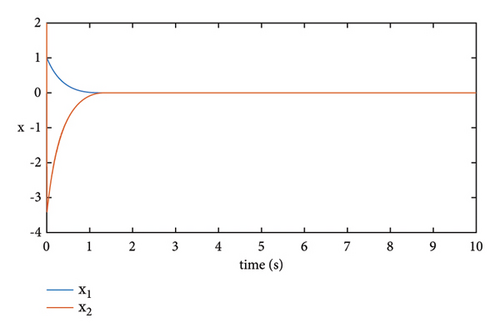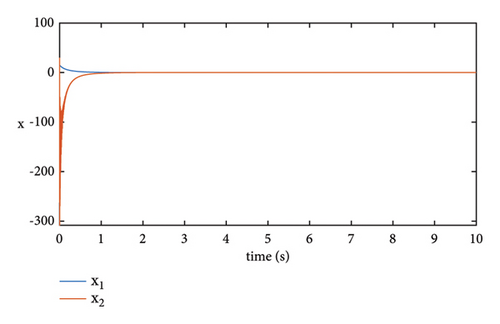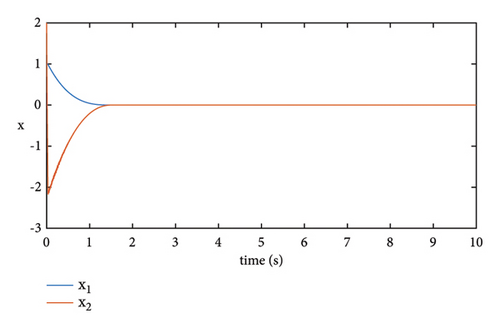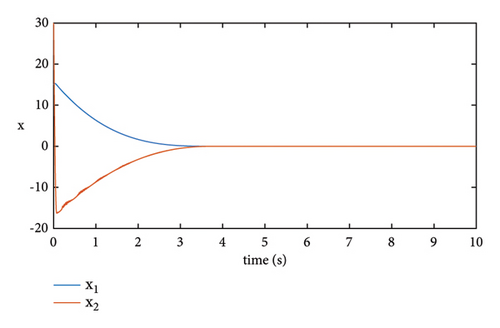Global Fixed-Time Stability of General Stochastic Nonlinear Systems
Abstract
In this article, the fixed-time stabilization issue is investigated for a kind of general p-norm stochastic nonlinear systems. The feature of the considered systems is that all powers are any positive rational numbers, which means this type of systems includes many previously considered systems. Firstly, a higher accurate upper bounded estimation of settling time is given by applying an ingenious variable transformation and the definition of Gamma function, thereby obtaining an improved stochastic fixed-time stability theorem. Then a continuous state-feedback controller is designed for the general p-norm stochastic systems by using the adding a power integrator method, and the designed controller is proved to ensure the fixed-time stability of the considered systems in light of stochastic fixed-time stability theorem. Finally, numerical simulation results of fixed-time stabilizer and finite-time stabilizer indicate the effectiveness of the developed scheme.
1. Introduction
Because of faster convergence, higher accuracy, and better robustness [1, 2], the finite-time stability of nonlinear systems has attracted a matter of great concern. Compared to deterministic nonlinear systems, finite-time stabilization problems of stochastic nonlinear systems were considered relatively later. Reference [3] first proposed a clear definition of finite-time stable in probability and established stochastic Lyapunov finite-time stability theorem. After that, many problems of finite-time stability/control have been addressed for various stochastic nonlinear systems. References [4, 5] have, respectively, investigated the characteristics of stochastic finite-time stability and the design of finite-time output-feedback stabilizing controller for stochastic nonlinear systems. The finite-time stabilization has been studied for switched and hybrid stochastic nonlinear systems in [6–8], successively. Notably, the upper bounded estimation of the settling time in finite-time convergence relies on the initial state. However, the initial conditions are usually unknown or not easily gained firsthand for many real systems. This implies that the practical applications of finite-time stability may be limited.
To overcome above obstacle, the fixed-time stability theorem was established [9], which shows that the upper bounded estimation of settling time would become independent of the initial condition. Subsequently, the fixed-time stabilization/control of various deterministic nonlinear systems has been studied in [10–16]. More specifically, references [10, 11] have considered fixed-time stabilization/tracking control for nonholonomic systems and multiagent ones, while fixed-time stabilization or HOSM controller has been addressed for output-constrained nonlinear systems and sliding mode systems in [12–14]. Whereas, the theorem about fixed-time stable in probability was just reported in [17] recent year. Subsequently, references [18, 19] have, respectively, investigated the fixed-time stability for switched stochastic nonlinear systems and stochastic multiagent ones. References [15, 16, 20] have provided new fixed-time Lyapunov criteria or improved methods for estimating the upper bounded function of the settling time in fixed-time convergence. But in contrast to deterministic nonlinear systems, the studies on fixed-time stability of stochastic nonlinear systems are still inadequate and not deep. Moreover, although having nothing with the initial condition, the upper estimation of settling time proposed in existing results yet may be relatively conservative owing to overamplification.
On the other hands, the p-norm stochastic nonlinear systems have attracted great attention because of their more general form and wilder application of which can model many complex systems, for instant the underactuated and weakly coupled mechanical system [21, 22]. For a class of p-norm stochastic nonlinear systems with powers being equal to or greater than 1 (called as stochastic high-order nonlinear systems), references [23–26] have investigated asymptotic/finite-time stabilization issues based on state feedback and output feedback. Meanwhile, the finite-time stabilizers have been developed for a kind of p-norm stochastic nonlinear systems, called as stochastic low-order nonlinear systems, every power of which is equal to or less than 1 [27–29]. Reference [30] has addressed finite-time stability of p-norm stochastic systems in a general form, in which every power is any positive odd rational numbers. In the aforementioned systems, the powers however are either only high-order or only low-order positive odd rational numbers. Two questions naturally arise. (i) Can the restriction on the powers of the p-norm system be further relaxed? (ii) The issue of fixed-time stability of p-norm stochastic systems is not considered and still open. How to arrive the fixed-time stability for p-norm stochastic nonlinear systems?
- (i)
Applying a subtle variable substitution and the properties of Gamma/Beta functions, one finds a higher accurate upper estimation of the settling time, which is less than the values in [17, 18]. On this basis, a corollary is provided for the stochastic fixed-time stability theorem.
- (ii)
The considered systems are more general than the systems in [23–30]. Significantly, the powers of the systems considered by references [23–30] are either only high-order positive odd rational numbers or only low-order positive ones. Specifically, the powers of systems in [23–26] are positive odd rational numbers and equal to or greater than 1, while the powers of systems in [27–29] are equal to or less than 1. Reference [30] has relaxed the restriction on the powers, which were required to be any positive odd rational numbers. Oppositely, all powers of the considered systems in this paper are any positive rational numbers, which can be any ratios of arbitrary positive odd or even numbers. In other words, the system considered here includes all the systems mentioned above. Meanwhile, a weaker restriction on system nonlinearities is provided and an appropriate Lyapunov function is presented.
- (iii)
The global fixed-time stability is studied for the more general p-norm stochastic nonlinear systems based on the improved stochastic fixed-time stability theorem for the first time.
2. Preliminaries
Some definitions and lemmas are provided in the following for preliminaries.
Definition 1 (see [4].)For any provided W(x) ∈ C2(Rn) of system (1), the second-order differential operator is defined as
Definition 2 (see [17].)For system (1), the origin x = 0 of system (1) is allowed to be globally fixed-time stable in probability, if the following two conditions are addressed: (i) for ∀x0 ∈ Rn, the origin is globally finite-time stable in probability; (ii) the settling time function T(x0, ω) satisfies , where is a constant independent of initial conditions.
Lemma 3 (see [17].)For system (1), if there is a positive definite and radially unbounded Lyapunov function W(x) ∈ C2(Rn) and positive real numbers λ, μ, α ∈ (1, +∞), and γ ∈ (0, 1), such that
Lemma 4 (see [12].)For ∀ m > 0 and variables Zj ∈ R, j = 1, …, N, one gets
Lemma 5 (see [12].)Let m1, m2 ∈ R+ with m1 ≥ 1. For any variables Z1, Z2 ∈ R, one has
Lemma 6 (see [26].)For any constants ϱ1 > 0, ϱ2 > 0 and variables Z1, Z2 ∈ R, one has
3. Main Results
3.1. Problem Description
Note that the fractional powers qi’s can take any positive real numbers, which indicates systems (8) contain all previously considered p-norm systems. For example, if qi’s are ratios of any two positive odd real numbers and satisfy qi ≥ 1, then systems (8) become high-order p-norm nonlinear systems. In other words, systems (8) can be regarded as a generalized p-norm stochastic nonlinear system.
Assumption 7. For ∀k = 1, …, n, there exist known smooth functions and such that
Remark 8. Of note, all of qi’s in system (8) are ratios of any positive real numbers, which means qi’s not only can take both odd and even rational numbers but also can be equal to or greater than or less than 1. In other words, system (8) is a more general class of p-norm systems than the considered p-norm systems with qi ≥ 1 in [23–26] and the ones with qi ≤ 1 in [27–29]. Besides, condition (9) is originated from reference [30]. Nevertheless, reference [30] has just considered the case of qi taking any odd rational numbers and the finite-time stability.
Now, this paper aims to find a higher accurate upper bounded estimation of the settling time and then construct a state-feedback controller to enable that the origin of system (8) is globally fixed-time stable in probability.
3.2. A Corollary
Definition 9 (see [31].)Let c > 0; then a Gamma function Γ(c) is defined as follows:
Definition 10 (see [32].)Let a > 0, b > 0; then a Beta function B(a, b) is defined as follows:
Now, we will provide a corollary of Lemma 3 in the following.
Corollary 11. For system (1), if there exists a positive definite and radially unbounded Lyapunov function W(x) ∈ C2(Rn) and real numbers λ > 0, μ > 0, α ∈ (1, +∞), and γ ∈ (0, 1), such that
Proof. Let ; then it is easy to get W = (μ/λ((1/z) − 1))(1/γ − α) and dW = ((μ/λ)(1/γ − α)/Z2(α − γ))((1/z) − 1)((1/γ − α) − 1)dZ. For ∀0 < ε < +∞, we can deduce
Since (1 − γ/α − γ) − 1 = −(α − 1/α − γ), (α − 1/α − γ) = −(1 − γ/γ − α) and (1 − γ/α − γ) + (α − 1/α − γ) = 1, it can be deduced from Definitions 9 and 10 that
In light of equations (14) and (15), equation (13) is proved.
Remark 12. Notably, Lemma 3 from [17] has shown the settling time [T(x0, ω) satisfying , while [T(x0, ω) in [15] satisfies . To get higher accurate estimation of settling time, one should choose a suitable estimation method. Unlike the estimating methods in [15, 17], both of which are simultaneously amplifying integral intervals and integrand, we only amplify integral intervals but keep integrable function unchanged in the proof of Corollary 11. Applying an ingenious variable transformation and the definitions of Gamma/Beta functions, we obtain a higher accurate upper-bounded estimation of the settling time. It is obvious to gain and .
3.3. Controller Design
In this part, one will apply the adding a power integrator method to explicitly construct a continuous state-feedback controller.
Step 1. Let , where the constant σ is taken as 0 < σ ≤ 1/2. Define the Lyapunov function W1(x1) as
Apparently, W1(x1) is positive definite and C2.
Using Definition 1 and Assumption 7, we can directly obtain
Then, one can design the virtual variable η2 as
Substituting (18) into (17) yields
Step k (2 ≤ k ≤ n − 1). Suppose at step k − 1, one finds a C2 and positive definite Lyapunov function and constructs k virtual control variables η1, η2, …, ηk as
Then, a proposition can be provided in the following.
Proposition 13. Select the Lyapunov function as with
Thus, is C2 and positive definite. Then, there exists a virtual controller such that
The proof of above proposition will be given in Appendix.
Heretofore, the actual controller is completely established for system (8).
3.4. Stability Analysis
Firstly, we provide a theorem to display the main results of this note.
Theorem 14. Suppose system (8) fulfills Assumption 7; then the designed actual controller (28) with virtual ones (20) can guarantee that the origin of system (8) is globally fixed-time stable in probability.
Proof. In light of the expression of Wn(x), one can easily get that Wn(x) is positive definite and radially unbounded. Further, using the integral mean value theorem and Lemma 5 infers that
Then, one gains
Here, we choose the constant parameter τ > δ, and it is clear that 0 < (4/4 + δ) < 1 and (4+τ)/(4 + δ) > 1. Therefore, one obtains from (31) and Lemma 4 that
In view of equations (29), (32), and (33), it is easy to get
Now, let λ = 2(−4/4 + δ)λ1 > 0, μ = 2(−4 − τ/4 + δ)n(δ − τ/4 + δ)μ1 > 0, 0 < γ = (4/4 + δ) < 1, and α = (4+τ)/(4+δ) > 1. According to (34), one has
Thus, we can conclude from (35) and Lemma 3 that controller (28) can make the origin of system (8) globally fixed-time stable in probability.
From Corollary 11, one can get that the settling time T(x0, ω) satisfies
Remark 15. Compared to the finite-time stabilizers of p-norm stochastic nonlinear systems in references [25–30], we design fixed-time stabilizers by adding a function into the controller gain in this paper. Because of this, the designed fixed-time controller guarantees that the system converges to the equilibrium point at a faster speed than the convergence rate under the finite-time controller. At the same time, we can obtain the upper estimation of settling time independent of initial conditions.
4. Simulation
Clearly, q1 = (8/9) < 1, q2 = (9/7) > 1, g1(x1) = φ1(x1) = 0, , and .
Choose s1 = 1 and θ = 2/3. Then, it can be obtained that s2 = q1/θ = 4/3, s3 = (q2/(θ + 1/s2 − 1)) = 108/35. Further, one gets q2s1/s3 = 5/12, s1/2s3(q2 + (s3/s2)) = 17/24, s2/2s3(q2 + (s3/s2)) = 7/9. Consequently, it is easy to deduce and , which means that Assumption 7 holds with ϕ1(x1) = ψ1(x1) = 0, and . We select σ = 1/2. According to design process, one defines and constructs the virtual variable . Furthermore, define .


On the other hand, we note that controller (39) would become a finite-time stabilizer if μ1 = 0. To compare fixed-time stability with finite-time stability, we also present Figures 3 and 4 to show the simulation result of system (38) under the finite-time stabilizing controller. From the two figures, we can find the finite-time stabilizing controller is effective, too. However, the fixed-time stabilizing controller not only can ensure independence between the upper hound estimation of the settling time and initial conditions but also can provide faster convergence rate than the finite-time one. Thus, the results of simulating demonstrate the validity of the presented scheme.


5. Conclusion
The problem on fixed-time stability is addressed for kinds of more general p-norm stochastic nonlinear systems, in which all powers are any positive rational numbers, instead of only odd numbers. Firstly, a subtle variable substitution is defined, and the Gamma function is next applied to amplify the integral and derive the upper bounder. Unlike the previous method, our technique performs only one amplification, which can derive a higher accurate upper bounded estimation of the settling time. Then a new theorem of fixed-time stable in probability is provided. Based on the new theorem, one has developed the fixed-time stabilizing control strategy for the general p-norm stochastic nonlinear systems. Then, both the mathematical analysis and simulation results illustrate the effectiveness of the developed strategy.
Conflicts of Interest
The authors declare that they have no conflicts of interest.
Acknowledgments
This work was supported by the National Natural Science Foundation of China (62103306) and Scientific Research Project of Anhui Higher Education Institutions (2022AH020094 and 2023AH051661). Talent Research Launch Fund Project of Tongling University (2023tlxyrc40) also supported this work.
Appendix
Proof of Proposition 13. In view of equation (22), one can get
Furthermore, we can infer from Definition 1 and equations (21) and (22) that
In what follows, the upper bounded estimations of every right-hand side in (A.2) will be provided. To this end, one gives four subpropositions.
Proposition 16. There are smooth functions , such that
Proof. It is obviously easy to get
Thus,
Proposition 17. There is a constant Dk1 ≥ 0 such that
Proof. Since qk−1σ/sk ≤ 1, by Lemma 5, we have
By using (A.10) and Lemma 6, one can easily derive
Proposition 18. There is a smooth function Dk2(⋅) ≥ 0 such that
Proof. Using Proposition 16 and Lemma 6, one easily obtains that
Proposition 19. There is a smooth function Dk3(⋅) ≥ 0 such that
Proof. As stated in [12], any continuous function has at least a smooth upper bound. Thus, for ∀j = 1, …, k − 1, there exist smooth functions and , such that
By Lemma 5, one has
Since qjσ/ sj + 1 = (θ + (1/ sj) − 1)σ and qkσ/sk+1 = (θ + (1/ sk) − 1)σ, it follows from (A.15) and (A.16) that
Letting can render equation (A.14) directly.
Proposition 20. There is a smooth function Dk4(⋅) ≥ 0 such that
Proof. Note that
First of all, it is not difficult to get
Secondly, if i ≠ j and i < j, one can derive that
Hence, for ∀1 ≤ i ≠ j ≤ k − 1, utilizing equations (A.15) and (A.23) and Lemma 6 can draw that
Then, one has
Let , Substituting (A.22) and (A.25)–(A.27) into (A.19) yields (A.18) directly.
Combining Propositions 16–20 with (A.2) indicates that
According to (A.28), one constructs the virtual variable ηk+1 as
Then, substituting (A.29) into (A.28) renders
Hence, we can gain that equations (A.29) and (A.30) hold for all k = 2, 3, …, n. That is, Proposition 13 has been well proved.
Open Research
Data Availability
No data were used to support this study.




